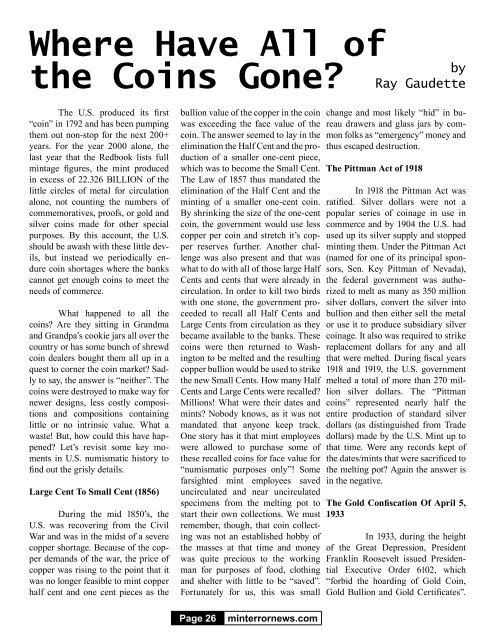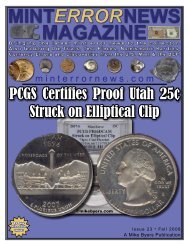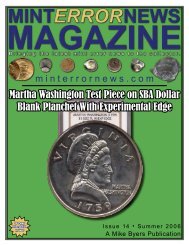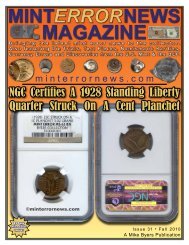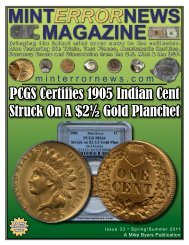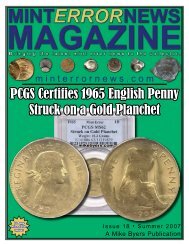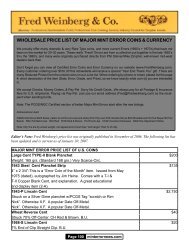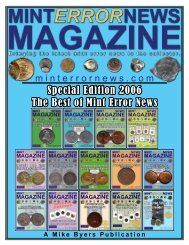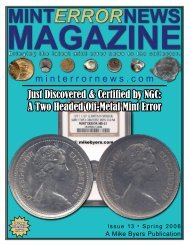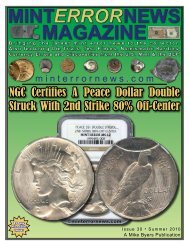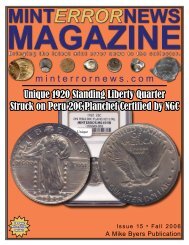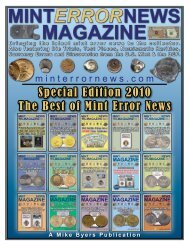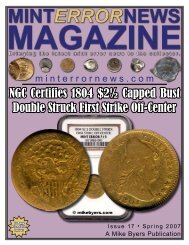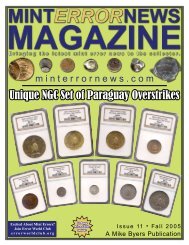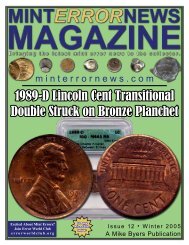Issue 1 - Mint Error News Magazine
Issue 1 - Mint Error News Magazine
Issue 1 - Mint Error News Magazine
You also want an ePaper? Increase the reach of your titles
YUMPU automatically turns print PDFs into web optimized ePapers that Google loves.
Where Have All of<br />
the Coins Gone?<br />
The U.S. produced its first<br />
“coin” in 1792 and has been pumping<br />
them out non-stop for the next 200+<br />
years. For the year 2000 alone, the<br />
last year that the Redbook lists full<br />
mintage figures, the mint produced<br />
in excess of 22.326 BILLION of the<br />
little circles of metal for circulation<br />
alone, not counting the numbers of<br />
commemoratives, proofs, or gold and<br />
silver coins made for other special<br />
purposes. By this account, the U.S.<br />
should be awash with these little devils,<br />
but instead we periodically endure<br />
coin shortages where the banks<br />
cannot get enough coins to meet the<br />
needs of commerce.<br />
What happened to all the<br />
coins? Are they sitting in Grandma<br />
and Grandpa’s cookie jars all over the<br />
country or has some bunch of shrewd<br />
coin dealers bought them all up in a<br />
quest to corner the coin market? Sadly<br />
to say, the answer is “neither”. The<br />
coins were destroyed to make way for<br />
newer designs, less costly compositions<br />
and compositions containing<br />
little or no intrinsic value. What a<br />
waste! But, how could this have happened?<br />
Let’s revisit some key moments<br />
in U.S. numismatic history to<br />
find out the grisly details.<br />
Large Cent To Small Cent (1856)<br />
During the mid 1850’s, the<br />
U.S. was recovering from the Civil<br />
War and was in the midst of a severe<br />
copper shortage. Because of the copper<br />
demands of the war, the price of<br />
copper was rising to the point that it<br />
was no longer feasible to mint copper<br />
half cent and one cent pieces as the<br />
bullion value of the copper in the coin<br />
was exceeding the face value of the<br />
coin. The answer seemed to lay in the<br />
elimination the Half Cent and the production<br />
of a smaller one-cent piece,<br />
which was to become the Small Cent.<br />
The Law of 1857 thus mandated the<br />
elimination of the Half Cent and the<br />
minting of a smaller one-cent coin.<br />
By shrinking the size of the one-cent<br />
coin, the government would use less<br />
copper per coin and stretch it’s copper<br />
reserves further. Another challenge<br />
was also present and that was<br />
what to do with all of those large Half<br />
Cents and cents that were already in<br />
circulation. In order to kill two birds<br />
with one stone, the government proceeded<br />
to recall all Half Cents and<br />
Large Cents from circulation as they<br />
became available to the banks. These<br />
coins were then returned to Washington<br />
to be melted and the resulting<br />
copper bullion would be used to strike<br />
the new Small Cents. How many Half<br />
Cents and Large Cents were recalled?<br />
Millions! What were their dates and<br />
mints? Nobody knows, as it was not<br />
mandated that anyone keep track.<br />
One story has it that mint employees<br />
were allowed to purchase some of<br />
these recalled coins for face value for<br />
“numismatic purposes only”! Some<br />
farsighted mint employees saved<br />
uncirculated and near uncirculated<br />
specimens from the melting pot to<br />
start their own collections. We must<br />
remember, though, that coin collecting<br />
was not an established hobby of<br />
the masses at that time and money<br />
was quite precious to the working<br />
man for purposes of food, clothing<br />
and shelter with little to be “saved”.<br />
Fortunately for us, this was small<br />
Page 26 minterrornews.com<br />
by<br />
Ray Gaudette<br />
change and most likely “hid” in bureau<br />
drawers and glass jars by common<br />
folks as “emergency” money and<br />
thus escaped destruction.<br />
The Pittman Act of 1918<br />
In 1918 the Pittman Act was<br />
ratified. Silver dollars were not a<br />
popular series of coinage in use in<br />
commerce and by 1904 the U.S. had<br />
used up its silver supply and stopped<br />
minting them. Under the Pittman Act<br />
(named for one of its principal sponsors,<br />
Sen. Key Pittman of Nevada),<br />
the federal government was authorized<br />
to melt as many as 350 million<br />
silver dollars, convert the silver into<br />
bullion and then either sell the metal<br />
or use it to produce subsidiary silver<br />
coinage. It also was required to strike<br />
replacement dollars for any and all<br />
that were melted. During fiscal years<br />
1918 and 1919, the U.S. government<br />
melted a total of more than 270 million<br />
silver dollars. The “Pittman<br />
coins” represented nearly half the<br />
entire production of standard silver<br />
dollars (as distinguished from Trade<br />
dollars) made by the U.S. <strong>Mint</strong> up to<br />
that time. Were any records kept of<br />
the dates/mints that were sacrificed to<br />
the melting pot? Again the answer is<br />
in the negative.<br />
The Gold Confiscation Of April 5,<br />
1933<br />
In 1933, during the height<br />
of the Great Depression, President<br />
Franklin Roosevelt issued Presidential<br />
Executive Order 6102, which<br />
“forbid the hoarding of Gold Coin,<br />
Gold Bullion and Gold Certificates”.


